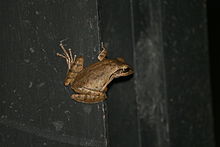Polypedates maculatus
| Polypedates maculatus | |
|---|---|

| |
| Scientific classification | |
| Domain: | Eukaryota |
| Kingdom: | Animalia |
| Phylum: | Chordata |
| Class: | Amphibia |
| Order: | Anura |
| Family: | Rhacophoridae |
| Genus: | Polypedates |
| Species: | P. maculatus
|
| Binomial name | |
| Polypedates maculatus (J.E.Gray, 1830)
| |
| Synonyms | |
| |
Polypedates maculatus, the Indian tree frog,[1] or Chunam tree frog, is a common species of tree frog found in South Asia. It was described by John Edward Gray in 1830.[2]
Although now considered as a separate species again, for a time, the
Description




These frogs measure about 7–8 cm in body length. They are mostly brownish, yellowish, greyish, or whitish above, with darker spots or markings, rarely with an hourglass-shaped figure on the back of the head and the front of the back. The loreal and temporal regions are dark; there is a light line on the upper lip. The hind side of the thighs has round, yellow spots, which are usually separated by a dark-brown or purplish network. The skin is smooth above, and granulated on the belly and under the thighs; a fold extends from the eye to the shoulder. Males have internal vocal sacs.[3]
The
The fingers are barely webbed, and the toes are two-thirds webbed. The disks of fingers and toes are moderately developed; that of the third finger measures two-fifths to one-half the diameter of the eye. The subarticular tubercles are of moderate size. When the hind leg is held alongside the body, the tibiotarsal articulation reaches the eye, or between the eye and the tip of the snout.[3]
Distribution and ecology
It is widespread throughout
They may use day roosts regularly. Their call is a sudden short and rapid series of rattling rat-tats.[4]
They wipe themselves with skin secretions consisting of mucus and lipids that help in reducing moisture loss. When temperatures are higher, they secrete from the skin ("sweat"), pant, and adopt lighter skin colours.[5]
In south India they can be a nuisance to households as they enter homes in search of food. They can climb walls with the help of their webbed feet and reach even higher floors, entering through the open windows.
Footnotes
- ^ . Retrieved February 1, 2024.
- ^ Grey 1830 Date is often given as "1833" but the volume in question was already out in 1830 (Wheeler 1998).
- ^ a b c Boulenger 1890
- ^ Kanamadi et al. 1993
- ^ Lillywhite et al. 1997, Lillywhite et al. 1998
References
- Boulenger, George Albert (1890), "61. Polypedates maculatus", Fauna of British India - Reptilia and Batrachia (DjVu), London: Taylor & Francis, pp. 475–476.
- Gray, John Edward (1830), "[Description of Polypedates maculatus]", Illustrations of Indian Zoology, p. 83, plate 82, Plate 82 image.
- Kanamadi, R. D.; Schneider, H.; Hiremath, C. R.; Jirankali, C. S. (1993), "Vocalization of the tree frog Polypedates maculatus (Rhacophoridae)." (PDF), Journal of Biosciences, 18 (2): 239–245, S2CID 26497326.
- Lillywhite, Harvey B.; Mittal, Ajay K.; Garg, Tarun K.; Agrawal, N. (1997), "Wiping Behavior and Its Ecophysiological Significance in the Indian Tree Frog Polypedates maculatus", JSTOR 1447843.
- Lillywhite, Harvey B.; Mittal, Ajay K.; Garg, Tarun K.; Das, Indraneil (1998), "Basking Behavior, Sweating and Thermal Ecology of the Indian Tree Frog, Polypedates maculatus", Journal of Herpetology, 32 (2), Journal of Herpetology, Vol. 32, No. 2: 169–175, JSTOR 1565293.
- Wheeler, A. (1998), "Dates of publication of J. E. Gray's Illustrations of Indian Zoology (1830–1835)", Archives of Natural History, 25 (3): 345–354, .

